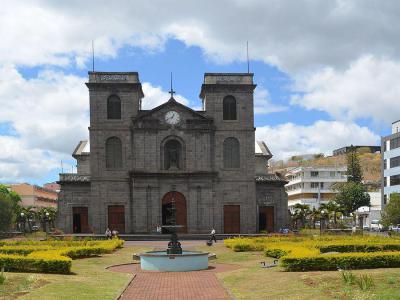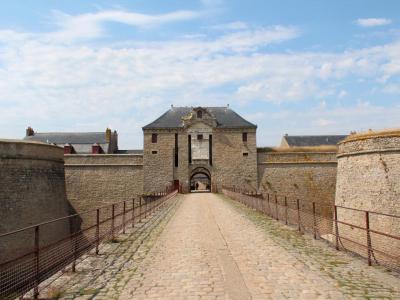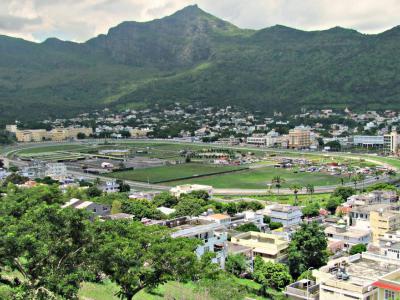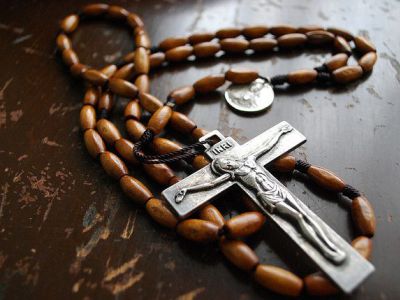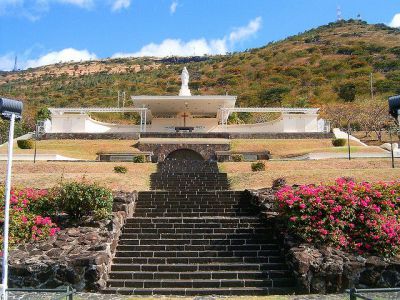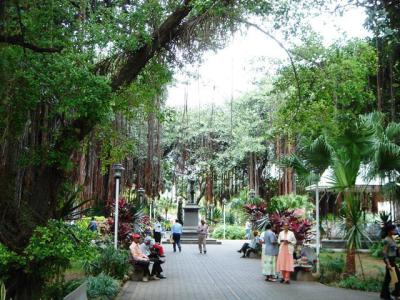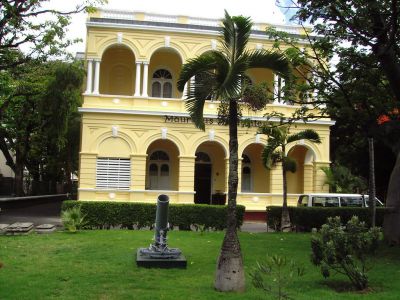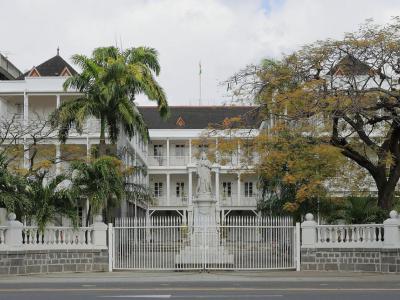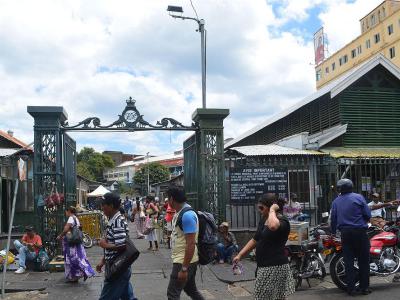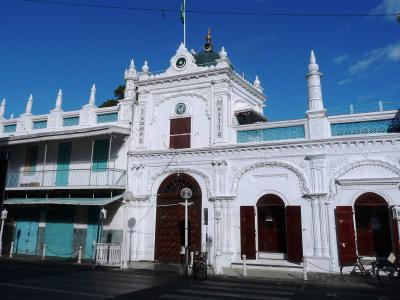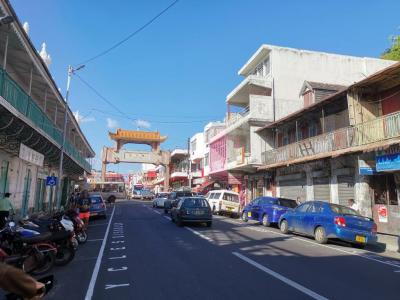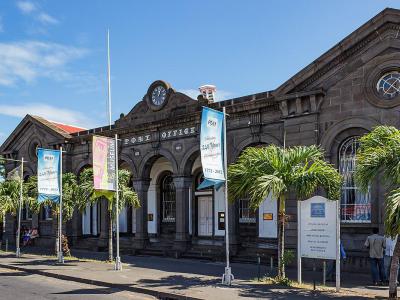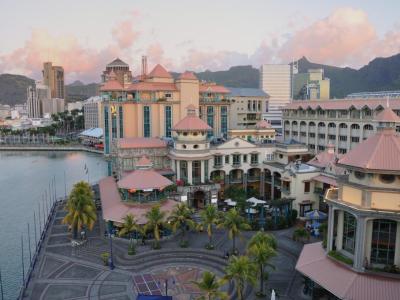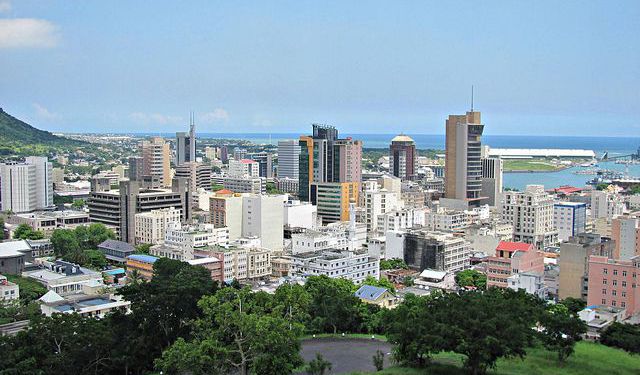
Port Louis Introduction Walking Tour (Self Guided), Port Louis
Port Louis, the capital of Mauritius, is a major commercial port and the island's main city with a wealth of colonial past carefully preserved and reflected in the local architecture, rendering Port Louis a colorful blend of the French, Indian and African influences. To explore the city's main attractions, follow this orientation walk.
How it works: Download the app "GPSmyCity: Walks in 1K+ Cities" from Apple App Store or Google Play Store to your mobile phone or tablet. The app turns your mobile device into a personal tour guide and its built-in GPS navigation functions guide you from one tour stop to next. The app works offline, so no data plan is needed when traveling abroad.
Port Louis Introduction Walking Tour Map
Guide Name: Port Louis Introduction Walking Tour
Guide Location: Mauritius » Port Louis (See other walking tours in Port Louis)
Guide Type: Self-guided Walking Tour (Sightseeing)
# of Attractions: 14
Tour Duration: 3 Hour(s)
Travel Distance: 5.9 Km or 3.7 Miles
Author: helenp
Sight(s) Featured in This Guide:
Guide Location: Mauritius » Port Louis (See other walking tours in Port Louis)
Guide Type: Self-guided Walking Tour (Sightseeing)
# of Attractions: 14
Tour Duration: 3 Hour(s)
Travel Distance: 5.9 Km or 3.7 Miles
Author: helenp
Sight(s) Featured in This Guide:
- Saint Louis Cathedral
- Fort Adelaide
- Champ de Mars Racecourse
- Saint James Cathedral
- Chapel and Shrine of Marie Reine de la Paix
- Company Gardens
- Natural History Museum
- Government House
- Central Market
- Jummah Mosque
- Chinatown
- Aapravasi Ghat
- Mauritius Postal Museum
- Le Caudan Waterfront
1) Saint Louis Cathedral
Saint Louis Cathedral was founded in 1933 and is the most popular religious building on the island of Mauritius. Every week Catholic worshipers gather here to pray. Saint Louis Cathedral was built in the Gothic style and is one of the oldest churches on the island, as a church has existed at this site since 1752.
2) Fort Adelaide (must see)
Fort Adelaide is a testament to the early years of British rule in the country. The fortress was built in the 19th century, specifically between 1834-1835, by Colonel Thomas Cunningham, and its construction was a challenging task due to the shortage of labor at the time, caused by the recent abolition of slavery. To build the fort, the British government initially relied on apprentices, freed slaves, prisoners, and even some soldiers. However, due to the lack of skilled labor, the government was forced to recruit stonemasons, masons, workers, and other craftsmen from India in 1837 to complete the construction.
The primary objective of building the fort was to protect the port from possible invasion and to quell any potential revolt from the local population. It was named Fort Adelaide in honor of Adelaide, wife of King William IV of England, and bears her initials and crown on the entrance pediment. Although the fort was never used for military or police purposes, it remains one of the few witnesses of the period between the abolition of slavery and the arrival of indentured laborers.
Unlike other forts built during the British period, such as Fort William and Fort Victoria, which have fallen into decay and oblivion, Fort Adelaide is the only one that remains intact. It is made of black basalt stones and is a testament to the skill of the craftsmen of the time. The fort was completed in 1840 and became a symbol of the beginning of Indian immigration and the end of slavery, not only because of those who contributed to its construction but also for the reasons that led to its construction.
During the 1830s, tensions ran high in Mauritius, which had recently come under British rule. The French established on the island were unhappy about the loss of the island and the prohibition of the slave trade, followed by the abolition of slavery. News of the French Revolution of 1830 only added to the tensions. The population of the island consisted of whites, people of color, and slaves, and the British authorities were concerned about the possibility of enemy attacks or a revolt. The construction of Fort Adélaïde was approved to provide defensive support in the event of invasion or revolt. The hill of Port-Louis was chosen as a strategic location to control the city, port, and slopes of the mountain.
When the fort was completed, the situation on the island had greatly improved, and it lost its original purpose. Instead, it was used to signal fires and the arrival of important personalities with cannon fire, or simply for daily cannon fire. Over the years, it has changed its vocation and has become a place of cultural initiatives, such as concerts, shows, and other events. Despite its change in purpose, Fort Adélaïde remains an important landmark in Mauritius and a symbol of the island's complex history.
The primary objective of building the fort was to protect the port from possible invasion and to quell any potential revolt from the local population. It was named Fort Adelaide in honor of Adelaide, wife of King William IV of England, and bears her initials and crown on the entrance pediment. Although the fort was never used for military or police purposes, it remains one of the few witnesses of the period between the abolition of slavery and the arrival of indentured laborers.
Unlike other forts built during the British period, such as Fort William and Fort Victoria, which have fallen into decay and oblivion, Fort Adelaide is the only one that remains intact. It is made of black basalt stones and is a testament to the skill of the craftsmen of the time. The fort was completed in 1840 and became a symbol of the beginning of Indian immigration and the end of slavery, not only because of those who contributed to its construction but also for the reasons that led to its construction.
During the 1830s, tensions ran high in Mauritius, which had recently come under British rule. The French established on the island were unhappy about the loss of the island and the prohibition of the slave trade, followed by the abolition of slavery. News of the French Revolution of 1830 only added to the tensions. The population of the island consisted of whites, people of color, and slaves, and the British authorities were concerned about the possibility of enemy attacks or a revolt. The construction of Fort Adélaïde was approved to provide defensive support in the event of invasion or revolt. The hill of Port-Louis was chosen as a strategic location to control the city, port, and slopes of the mountain.
When the fort was completed, the situation on the island had greatly improved, and it lost its original purpose. Instead, it was used to signal fires and the arrival of important personalities with cannon fire, or simply for daily cannon fire. Over the years, it has changed its vocation and has become a place of cultural initiatives, such as concerts, shows, and other events. Despite its change in purpose, Fort Adélaïde remains an important landmark in Mauritius and a symbol of the island's complex history.
3) Champ de Mars Racecourse (must see)
Champ de Mars is a famous thoroughbred horse race track. It was inaugurated on 25 June 1812 by the Mauritius Turf Club (MTC), which is the oldest horse-racing club in the Southern Hemisphere and the second oldest in the world. The track follows a very selective right-hand oval path and is relatively small in size, with a circumference of 1,298 meters (4,258.5 ft) and a width between 12 and 14 meters (39 and 46 feet). The home straight extends uphill and is 225 meters (738 ft) long.
Before the establishment of the racecourse, the area was a military training ground for French troops. The founders of the Mauritius Turf Club aimed to set up horse racing at Champ de Mars to reconcile the French settlers with the English administration, who had conquered the island in December 1810. They believed that the convivial atmosphere of horse racing would foster unity between the two communities and ensure social peace and harmony after years of fighting in the Indian Ocean.
The Champ de Mars racecourse has played a fundamental role in propelling horse racing as the most popular sport and form of entertainment among the local population. The racecourse attracts tens of thousands of people on each racing day during the racing season, which runs from late March to early December, making it the ultimate meeting place for racing fanatics from all over the island and even from abroad.
The track has undergone significant improvements over the years, with the addition of new facilities while retaining the colonial aspects of the racecourse. Notable royal visits to Champ de Mars include those of Queen Elizabeth II, Princess Margaret, Countess of Snowdon, and Prince William, Duke of Cambridge.
The Champ de Mars racecourse has a rich history, and its founder, Colonel Edward Draper, is known as the "Father" of the Mauritius Turf Club. The main road leading to the racecourse is a landmark known to race enthusiasts as "Rue Government." Within the premises stands a statue of King Edward VII by the sculptor Prosper d'Épinay and the Malartic Tomb, an obelisk to a French governor.
Before the establishment of the racecourse, the area was a military training ground for French troops. The founders of the Mauritius Turf Club aimed to set up horse racing at Champ de Mars to reconcile the French settlers with the English administration, who had conquered the island in December 1810. They believed that the convivial atmosphere of horse racing would foster unity between the two communities and ensure social peace and harmony after years of fighting in the Indian Ocean.
The Champ de Mars racecourse has played a fundamental role in propelling horse racing as the most popular sport and form of entertainment among the local population. The racecourse attracts tens of thousands of people on each racing day during the racing season, which runs from late March to early December, making it the ultimate meeting place for racing fanatics from all over the island and even from abroad.
The track has undergone significant improvements over the years, with the addition of new facilities while retaining the colonial aspects of the racecourse. Notable royal visits to Champ de Mars include those of Queen Elizabeth II, Princess Margaret, Countess of Snowdon, and Prince William, Duke of Cambridge.
The Champ de Mars racecourse has a rich history, and its founder, Colonel Edward Draper, is known as the "Father" of the Mauritius Turf Club. The main road leading to the racecourse is a landmark known to race enthusiasts as "Rue Government." Within the premises stands a statue of King Edward VII by the sculptor Prosper d'Épinay and the Malartic Tomb, an obelisk to a French governor.
4) Saint James Cathedral
Saint James Cathedral is situated near Saint Louis Cathedral and opened in 1850. The church's interior is composed primarily of wood. Inside you will find numerous name plates that commemorate notable Mauritian residents of the past. It has a quiet, relaxing atmosphere, making it an ideal place to pray or gather your thoughts.
5) Chapel and Shrine of Marie Reine de la Paix
The Chapel and Shrine of Marie Reine de la Paix is situated on a hill at the outskirts of the city. This religious building is very popular not only with the locals, but also with tourists who come to admire the building's modern architecture. The chapel is surrounded by a green area from which you can enjoy a great view of Port Louis.
6) Company Gardens (must see)
The Company Gardens in Port Louis is a haven of peace and rest amidst the bustling city. Located in the center of the city, in front of the Mauritius Institute, this garden is known for its gigantic trees that play strident Indian music, showcasing the preeminence of Hindi culture on the island. The garden's name comes from the fact that it formerly belonged to the India Company French. Initially a swamp, the place was transformed into a botanical park by Mahé de La Bourdonnais in 1735 and then repopulated with trees under British rule in 1828.
Today, the Company Gardens is a popular destination for people in Port Louis who go there to rest or have lunch under the shade of the trees. The park is also full of statues, busts, and monoliths dedicated to the heroes of Mauritius, as well as dating posters of poems and novels. Visitors can take a break and enjoy a drink before continuing to explore the city.
The Company Gardens is often referred to as the Central Park of Mauritius, despite being smaller and more restricted in size. The journey through the huge trees in the middle of a constantly active city leaves a lasting impression. Upon arrival, visitors are greeted by two enormous totems representing dragons and Chinese lions that stand as the guardians of the garden. The setting is remarkable, with a union between the concrete of modernity and the greenery of nature.
Apart from the great men statues such as Adrien d'Épinay and Ti-Frère, visitors can also take pictures with century-old banyan trees, which are the last ones still existing in Mauritius and the Mascarene Islands. The northern part of the garden is also known for its tropical flower gardens, which emit a sweet floral scent. Visitors can stay in the shade of the big palm trees and admire the beautiful fountain and its cement dolphins.
Today, the Company Gardens is a popular destination for people in Port Louis who go there to rest or have lunch under the shade of the trees. The park is also full of statues, busts, and monoliths dedicated to the heroes of Mauritius, as well as dating posters of poems and novels. Visitors can take a break and enjoy a drink before continuing to explore the city.
The Company Gardens is often referred to as the Central Park of Mauritius, despite being smaller and more restricted in size. The journey through the huge trees in the middle of a constantly active city leaves a lasting impression. Upon arrival, visitors are greeted by two enormous totems representing dragons and Chinese lions that stand as the guardians of the garden. The setting is remarkable, with a union between the concrete of modernity and the greenery of nature.
Apart from the great men statues such as Adrien d'Épinay and Ti-Frère, visitors can also take pictures with century-old banyan trees, which are the last ones still existing in Mauritius and the Mascarene Islands. The northern part of the garden is also known for its tropical flower gardens, which emit a sweet floral scent. Visitors can stay in the shade of the big palm trees and admire the beautiful fountain and its cement dolphins.
7) Natural History Museum (must see)
The Natural History Museum is the oldest museum on the island. It exhibits all kinds of marine creatures and has an extensive collection of now-extinct birds and reptiles. The most recognized item in this museum is a well-preserved Dodo bird. Admission to the museum is free, but you cannot take any photos inside.
8) Government House (must see)
Government House is one of the most historic buildings in Port Louis, the capital city of Mauritius. Dubbed as the oldest building of the capital, it was built during the French colonization era and served as the residence of the first French governor of Mauritius. The construction of this building was supervised by the governor himself, and its architecture is typical of the period.
The Government House has a strong historical significance and is considered an architectural gem. The building has undergone several renovations and upgrades over the years to preserve its original beauty and charm. Today, it serves as the official residence of the President of the Republic of Mauritius and is not open to the general public.
One of the most striking features of the Government House is the statue of Queen Victoria that stands in front of the building. The statue was erected during the British colonial period and is a testament to the island's colonial history. The statue portrays Queen Victoria with an air of un-amused indifference, which is quite characteristic of her personality.
Visitors to the Government House can still admire the architecture of the building from the outside, which is a blend of French and British styles. The building's main entrance is adorned with a beautiful wrought-iron gate and a flight of steps leading up to the entrance. The building's walls are made of local stone, and the roof is covered with red tiles.
The Government House has a strong historical significance and is considered an architectural gem. The building has undergone several renovations and upgrades over the years to preserve its original beauty and charm. Today, it serves as the official residence of the President of the Republic of Mauritius and is not open to the general public.
One of the most striking features of the Government House is the statue of Queen Victoria that stands in front of the building. The statue was erected during the British colonial period and is a testament to the island's colonial history. The statue portrays Queen Victoria with an air of un-amused indifference, which is quite characteristic of her personality.
Visitors to the Government House can still admire the architecture of the building from the outside, which is a blend of French and British styles. The building's main entrance is adorned with a beautiful wrought-iron gate and a flight of steps leading up to the entrance. The building's walls are made of local stone, and the roof is covered with red tiles.
9) Central Market (must see)
The Port Louis Market is a vibrant and bustling marketplace located in the heart of Mauritius. It is a must-visit destination for anyone interested in experiencing the local way of life and discovering the unique culture of the island.
The market is divided into several sections, each offering a different kind of product. The fruit and vegetable section is a colorful and aromatic display of locally grown produce, with a wide variety of tropical fruits and vegetables on offer. The meat and seafood section is equally impressive, with fresh catches from the Indian Ocean and locally reared meats.
The shopping mall upstairs is a great place to find souvenirs, with a wide range of locally made handicrafts, textiles, and other artifacts available at very reasonable prices. Whether you're looking for a unique piece of jewelry, a hand-carved wooden figurine, or a brightly colored sarong, you're sure to find something to suit your taste at the Port Louis Market.
Foodies will love the food section of the market, which is a veritable feast for the senses. Here, you can sample some of the island's most delicious local dishes, including Dholl Puri, Briani, Halim, and many other traditional Mauritian dishes. The food is cheap, fresh, and delicious, and the atmosphere is lively and convivial, making it a great place to meet locals and other travelers.
The market is divided into several sections, each offering a different kind of product. The fruit and vegetable section is a colorful and aromatic display of locally grown produce, with a wide variety of tropical fruits and vegetables on offer. The meat and seafood section is equally impressive, with fresh catches from the Indian Ocean and locally reared meats.
The shopping mall upstairs is a great place to find souvenirs, with a wide range of locally made handicrafts, textiles, and other artifacts available at very reasonable prices. Whether you're looking for a unique piece of jewelry, a hand-carved wooden figurine, or a brightly colored sarong, you're sure to find something to suit your taste at the Port Louis Market.
Foodies will love the food section of the market, which is a veritable feast for the senses. Here, you can sample some of the island's most delicious local dishes, including Dholl Puri, Briani, Halim, and many other traditional Mauritian dishes. The food is cheap, fresh, and delicious, and the atmosphere is lively and convivial, making it a great place to meet locals and other travelers.
10) Jummah Mosque (must see)
The Jummah Mosque is a historically significant mosque that dates back to the 1850s. Initially, a house on the property was used as a temporary place of worship while the mosque was being constructed. In 1853, the mosque was consecrated, and it was initially known as the "Mosque of the Arabs" after its founders, who were mistakenly believed to be Arabs.
Over time, the Muslim community in Port-Louis grew, and the mosque needed to be expanded to accommodate more worshippers. Several lots around the mosque were purchased between 1857 and 1877 by Muslim merchants and donated to the mosque. The expansion works began in 1878 and were overseen by Jackaria Jan Mahomed, but disease and a shortage of construction supplies delayed the completion until 1895.
Today, the Jummah Mosque is an impressive blend of Indian, Creole, and Islamic architecture. The mosque's design incorporates Moorish and Mughal influences, and it occupies an entire city block. The former Mosque of the Arabs has been integrated into the expanded building and serves as the main prayer hall. The prayer hall is illuminated by beautiful glass chandeliers.
One of the most interesting features of the Jummah Mosque is the Indian almond or badamia tree that stands in the middle of the courtyard. This tree was already present on the land when it was purchased in 1852, and it has remained an important part of the mosque's history and heritage.
The Jummah Mosque also has a unique historical significance, as it houses the remains of Jamal Shah, a pir from Kutch, India. His marble tomb is located next to the mosque, and it is a popular destination for visitors who come to pay their respects.
Over time, the Muslim community in Port-Louis grew, and the mosque needed to be expanded to accommodate more worshippers. Several lots around the mosque were purchased between 1857 and 1877 by Muslim merchants and donated to the mosque. The expansion works began in 1878 and were overseen by Jackaria Jan Mahomed, but disease and a shortage of construction supplies delayed the completion until 1895.
Today, the Jummah Mosque is an impressive blend of Indian, Creole, and Islamic architecture. The mosque's design incorporates Moorish and Mughal influences, and it occupies an entire city block. The former Mosque of the Arabs has been integrated into the expanded building and serves as the main prayer hall. The prayer hall is illuminated by beautiful glass chandeliers.
One of the most interesting features of the Jummah Mosque is the Indian almond or badamia tree that stands in the middle of the courtyard. This tree was already present on the land when it was purchased in 1852, and it has remained an important part of the mosque's history and heritage.
The Jummah Mosque also has a unique historical significance, as it houses the remains of Jamal Shah, a pir from Kutch, India. His marble tomb is located next to the mosque, and it is a popular destination for visitors who come to pay their respects.
11) Chinatown (must see)
Chinatown in Port Louis is a cultural gem within the busy capital of Mauritius. Although it is relatively small and less animated compared to Chinatown areas in other countries, it has a unique charm that reflects the Chinese contribution and culture throughout the years. The area runs for about 500 meters along the well-known ‘Rue Royale’ in Port Louis and is a true cultural heritage for Mauritius.
The first wave of Chinese immigration to Mauritius took place during the 18th century, and thousands of voluntary migrants settled along the street in the center of Port Louis, forming a small Chinatown. They worked as blacksmiths, carpenters, cobblers, and tailors. While most of the first Chinese migrants spoke Cantonese, those speaking Hakka grew in number, coming from Meixian, further east in Canton. Over time, more immigrants came to the area, and they were directed to Chinatown, where it was easier for them to settle with the help of those who were already living there. By mid-century, the total population of Chinese residents reached 5,000.
Nowadays, Chinatown is a living proof of the Chinese contribution and culture throughout the years, although the Chinese community in the Mauritian population comprises only a minority (3%). The streets in Chinatown are always busy on weekdays, and people rush around for business meetings and trading.
The area is well-known for its tasty food, and Chinese cuisine now forms an integral part of Mauritian culture. Fried noodles, dumplings, chopsuey, and Pekin ducks are dishes that are appreciated by all Mauritians, whatever their origin. The old shops found there offer a wide variety of articles ranging from toys, Chinese paintings, clothes, and books all under the same roof and at cheaper prices. There are also shops that deal in traditional medicines, and the smell of Chinese spices along with authentic Chinese cakes will tease your taste buds.
Every year, Chinatown holds a food festival that celebrates the diversity of Chinese cuisine. This is the perfect occasion to enjoy a melting pot of flavors and immerse yourself in the Chinese culture. Crowds of people gather around the spicy smelling stalls and discover unknown dishes and traditions straight from the land of the rising sun. The event also enables you to enjoy typical Chinese shows such as lion and dragon dances, cracking of firecrackers, street arts performances, cultural and music shows, martial arts demonstrations, Chinese games, and Chinese calligraphy.
This is the perfect time for a stroll in the streets with the opportunity to visit numerous shops and grocery stores selling a variety of items. Taste the delicious foods such as noodles, dim sum, dumplings, paow, Moon-cake, and many more on the menu, at the sound of traditional Chinese music.
The first wave of Chinese immigration to Mauritius took place during the 18th century, and thousands of voluntary migrants settled along the street in the center of Port Louis, forming a small Chinatown. They worked as blacksmiths, carpenters, cobblers, and tailors. While most of the first Chinese migrants spoke Cantonese, those speaking Hakka grew in number, coming from Meixian, further east in Canton. Over time, more immigrants came to the area, and they were directed to Chinatown, where it was easier for them to settle with the help of those who were already living there. By mid-century, the total population of Chinese residents reached 5,000.
Nowadays, Chinatown is a living proof of the Chinese contribution and culture throughout the years, although the Chinese community in the Mauritian population comprises only a minority (3%). The streets in Chinatown are always busy on weekdays, and people rush around for business meetings and trading.
The area is well-known for its tasty food, and Chinese cuisine now forms an integral part of Mauritian culture. Fried noodles, dumplings, chopsuey, and Pekin ducks are dishes that are appreciated by all Mauritians, whatever their origin. The old shops found there offer a wide variety of articles ranging from toys, Chinese paintings, clothes, and books all under the same roof and at cheaper prices. There are also shops that deal in traditional medicines, and the smell of Chinese spices along with authentic Chinese cakes will tease your taste buds.
Every year, Chinatown holds a food festival that celebrates the diversity of Chinese cuisine. This is the perfect occasion to enjoy a melting pot of flavors and immerse yourself in the Chinese culture. Crowds of people gather around the spicy smelling stalls and discover unknown dishes and traditions straight from the land of the rising sun. The event also enables you to enjoy typical Chinese shows such as lion and dragon dances, cracking of firecrackers, street arts performances, cultural and music shows, martial arts demonstrations, Chinese games, and Chinese calligraphy.
This is the perfect time for a stroll in the streets with the opportunity to visit numerous shops and grocery stores selling a variety of items. Taste the delicious foods such as noodles, dim sum, dumplings, paow, Moon-cake, and many more on the menu, at the sound of traditional Chinese music.
12) Aapravasi Ghat (must see)
Aapravasi Ghat is a historic site that played a pivotal role in the immigration of indentured laborers from India to various British colonies between 1849 and 1923. The site is also known as the Immigration Depot or Coolie Ghat.
During this period, over half a million Indian indentured laborers passed through the Immigration Depot in Mauritius, where they were processed and transported to work on plantations across the British Empire. The scale of this migration had a significant impact on the societies and cultures of many former British colonies, including Mauritius, where people of Indian ancestry now make up a substantial proportion of the population.
The Immigration Depot consisted of a complex of buildings that served as a transit point for indentured laborers. However, due to unchecked infrastructural development in the mid-20th century, only partial remains of three stone buildings from the entire complex have survived to date. These buildings are now protected as a national monument under the Mauritian national heritage legislation.
The Aapravasi Ghat Trust Fund manages the site, and conservation efforts are underway to restore the fragile buildings to their 1860s state. In recognition of its historical significance, UNESCO declared the Immigration Depot a World Heritage Site in 2006.
During this period, over half a million Indian indentured laborers passed through the Immigration Depot in Mauritius, where they were processed and transported to work on plantations across the British Empire. The scale of this migration had a significant impact on the societies and cultures of many former British colonies, including Mauritius, where people of Indian ancestry now make up a substantial proportion of the population.
The Immigration Depot consisted of a complex of buildings that served as a transit point for indentured laborers. However, due to unchecked infrastructural development in the mid-20th century, only partial remains of three stone buildings from the entire complex have survived to date. These buildings are now protected as a national monument under the Mauritian national heritage legislation.
The Aapravasi Ghat Trust Fund manages the site, and conservation efforts are underway to restore the fragile buildings to their 1860s state. In recognition of its historical significance, UNESCO declared the Immigration Depot a World Heritage Site in 2006.
Sight description based on Wikipedia.
13) Mauritius Postal Museum (must see)
The Postal Museum is located near the Post Office of Mauritius. The 18th-century stone edifice housing the museum is small. It once served as a hospital, but today it is a National Heritage building. The Postal Museum's mission is to develop philately on the island and to preserve locally-made stamps, which are valued highly around the world.
14) Le Caudan Waterfront (must see)
Le Caudan Waterfront is a modern shopping mall that offers a wide range of shopping, entertainment, and dining options. Visitors can find the latest fashion shops and trends, a popular arts and craft market, known as the Craft Market, specialty shops selling unique local goods such as replica ships, Indian garments, locally fabricated jewelry, or art paintings from local artists. The shopping center also boasts cinemas, a marina, a bookstore, restaurants and cafes, a museum, hosting two of the rarest stamps in the world, a casino and tax-free shopping options for tourists.
Despite being the first shopping mall on the island, Le Caudan Waterfront has been able to keep up with the trends and maintain its allure as a modern waterfront mall. Visitors can admire the workings going on in the port as large container and cruise ships make their way in and out.
Despite being the first shopping mall on the island, Le Caudan Waterfront has been able to keep up with the trends and maintain its allure as a modern waterfront mall. Visitors can admire the workings going on in the port as large container and cruise ships make their way in and out.
The Most Popular Cities
/ view all
